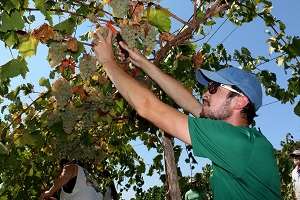By Merritt Melancon

Fall may be known as harvest time for peanuts, cotton and apples in Georgia, but the state’s winemakers would like Georgians to start thinking about grapes when the leaves start to transition to red and orange.
Between August and mid-October, Georgia’s 70 or so traditional vineyard owners will harvest just over 500 acres of wine grapes.
Thanks to the lack of rain toward the end of the summer, this year's harvest looks good, said Larry Lykins, President of Georgia Wine Producers, and owner and operator of Cartecay Vineyards in Ellijay, Georgia.
“It’s still just farming,” Lykins said. “People forget that when (they’re) sipping on a glass of wine, but winemaking is, first and foremost, farming. You can’t make a better wine than the quality of the grapes that you bring in from the field, so our goal is to simply grow the best grapes we can.”
Over the three decades since a fringe group of north Georgia farmers started the state’s first few vineyards, vineyard and winery owners have worked to gain a foothold for the state in the world of wine, while managing the challenges that come with farming wine grapes in Georgia. In the last few seasons, with the addition of multiple north Georgia vineyards, as well as the establishment of vineyards in the southern Piedmont region, Georgia’s wine industry is hitting critical mass, Lykins said.
“It started in 1980 with Georgia Winery and Habersham Winery; that was the first wave,” Lykins said. “Then we had the second wave with about 8 to 10 vineyards opening in the 1990s, and then we had a third wave between 2008 and 2012. That’s when we opened.
“As for what we’re seeing today, I wouldn’t even call it a wave anymore. It’s just steady growth.”
Georgia is no stranger to grape farming. It’s still one of the nation’s largest producers of muscadine grapes, and up until the time prohibition was implemented, it was the nation’s sixth-largest producer of European-style wine grapes and wine.
A lot of wine grape knowledge was lost when Prohibition wiped out Georgia’s wine industry, and ever since the restart of the Georgia wine industry, vineyard owners have had a steep learning curve as they’ve grown their businesses.
On-Farm Experimentation
“Georgia’s wine industry — or more accurately stated, Georgia’s modern wine industry — is relatively new,” said Lykins, who started his vineyard in 2008. “It’s a relatively new winegrowing region, Georgia, and there’s a lot we need to learn. We know some things that work well, but there are still a lot of things that we have to learn from trial and error.”
University of Georgia Cooperative Extension has offered support to Georgia’s winegrowers where they can, but Extension hasn’t had money allocated to fund a state viticulture specialist until now. UGA administrators plan to hire that person in the next six months.
The new viticulturist hire will be exciting for vineyard owners who need better information on pest control, variety selection and growing practices, Lykins said.
Up to this point, many of the advances made in Georgia’s wine industry have been made through on-farm experimentation like the trials being run at the Blairsville experiment station with Dr. Phil Brannen. UGA Extension agent Paula Burke, vineyard consultant Fritz Westover and Trillium Vineyards owner Bruce Cross are also running trials in Carroll County, Georgia.
Cross grows hybrid wine grapes that were popularized in the Texas Hill Country and have made wine production in Georgia’s southern Piedmont region possible.
Grape varieties like Norton, Lenoir and Blanc du Bois are more resistant to the diseases brought on by the heat and humidity of middle and south Georgia, Burke said.
These are not new varieties, but they’re new to west Georgia, and they’ve allowed west Georgia’s wine industry to grow. Burke said that over the past five years, she’s had 10 vineyards open in her region.
“These varieties like our Georgia climate a little bit better,” she said. “They’re very vigorous; they actually prefer poor soil and they make great wines.”
Burke is working with Westover, who is based in Texas, and the staff at UGA's Agricultural & Environmental Services Laboratories in Athens, Georgia, to document the best growing practices and variety selections for Georgia’s south Piedmont Wine Country.
They’re testing to see what situations lead to the best yield and quality for grapes, but also to see which trellising systems minimize harvest times.
Try Georgia Wines
“All of these vineyards opening means we’re going to see more local wine out there,” Burke said. “These hybrid varietals will have names that most people aren’t familiar with, but you’re going to see them more and more.”
There is an ever-increasing number of Georgia-grown wines available at restaurants and bottle shops across the state. The only thing that people need to do is give them a try, and they will, Lykins said.
“There’s still a stigma against Georgia wines,” Lykins said. “But that’s being eroded away slowly but surely, just by people being exposed to our local Georgia wines. Once they try them, they will see that quality wine can and does come from Georgia.”
Source: uga.edu